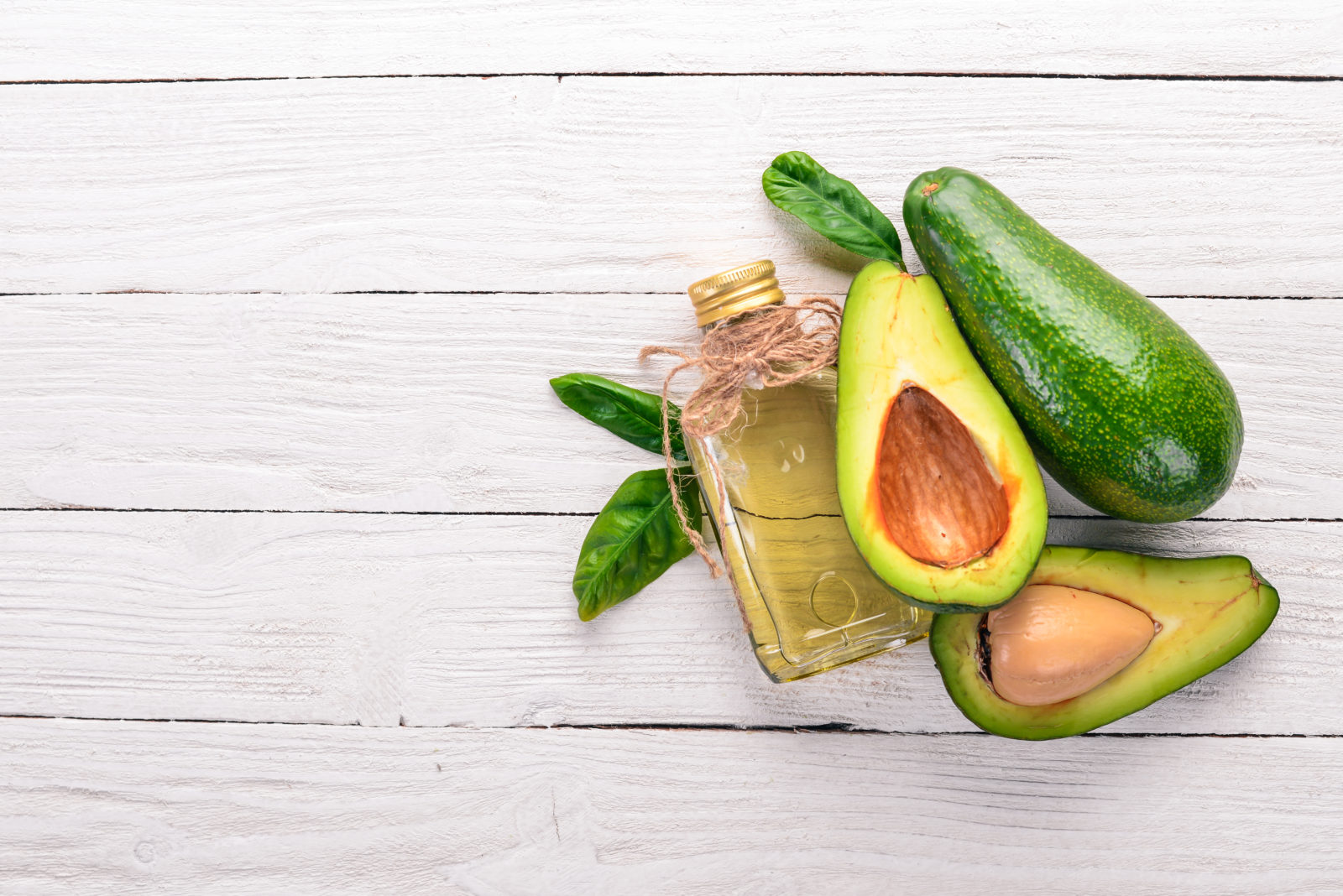What is an Avocado?
An avocado (Peruses americana) is a tropical and subtropical fruit native to Mexico and Central America (Araujo, R.G., et al., 2018). It belongs to the Lauraceae family making it related to the cinnamon tree, Bay laurel tree as well as camphor. It is classified as a berry, as it is comprised of a single seed and a pericarp (Ed. Terry, L., 2012). The Persea genus contains 150 species, 70 of which are cultivated in North, Central and South America, the rest being grown in Southeastern Asia. The name avocado is derived from the Aztec word ahucati (Gupta, S.K., et al., 2019).
Health Benefits of Avocado
The avocado is an incredibly beneficial fruit for one’s health. It is nutrient-dense, filled which healthy monounsaturated fatty acids, and plenty of vitamins and minerals. Here are eight benefits of avocado.
Balancing Cholesterol Levels
Research about whether avocados aid in lowering cholesterol is mixed. Some have shown a decrease in cholesterol levels and blood pressure while others have found no change (Mahmassani, H.A., et al., 2018).
Tocopherols, also known as vitamin E, is a potent antioxidant and has shown to protect tissues from lipid peroxidation, by preventing free radical damage and oxidative stress to LDL receptors (Imafidon, K.E., et al., 2010).
A 2018 study that observed rats with hypocholesterolaemia (high levels of cholesterol in the blood) found that over four weeks, avocado oil helped to lower LDL cholesterol levels as well as increase HDL cholesterol levels. Hypercholesterolaemia, which is a chronic disease, harms the liver, assisting in the development of fatty liver disease as well as atherosclerosis. the addition of avocado oil positively showed liver damage improvement in the study (Tan, C.X, et al., 2018).
A similar study was done on patients with hypercholesterolemia in 1996, it observed similar findings. The study found that healthy individuals saw a 16 percent decrease in serum cholesterol levels with the introduction of avocado into their diets. Patients with hypercholesterolemia found a 22% decrease in LDL cholesterol, as well as an increase of 11% for HDL cholesterol. The study concluded that the introduction of avocado into the diet had the potential to improve lipid profiles in patients with high levels of cholesterol (Lopez, L.R., et al.).
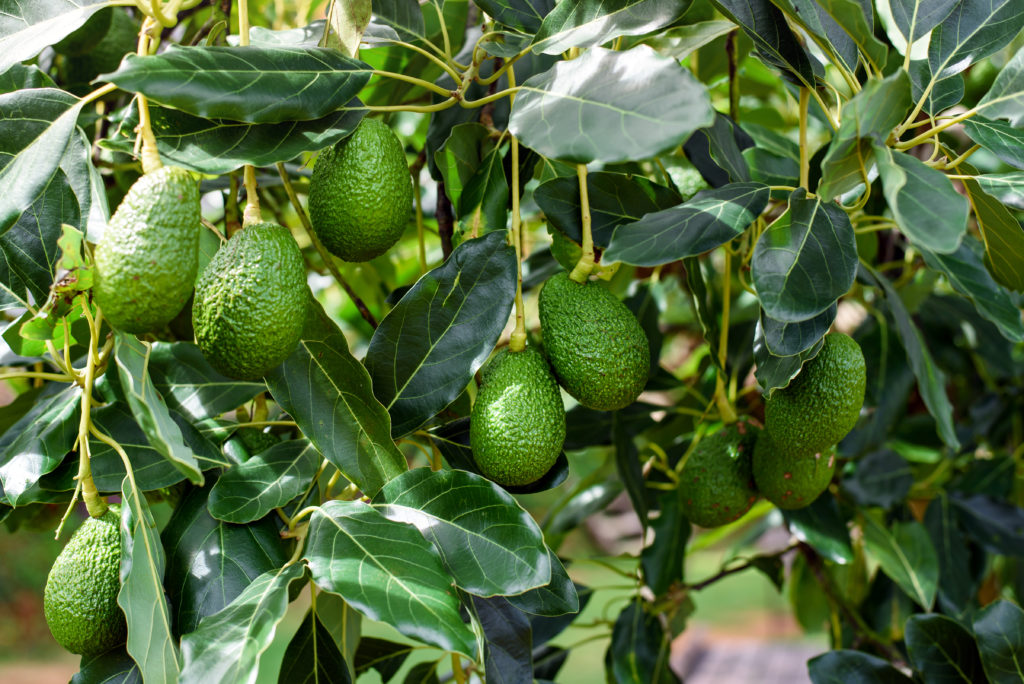
Avocados and Heart Health
Cardiovascular disease involves a range of diseases that affect the heart and the arteries such as coronary heart disease, high blood pressure, heart failure, and stroke and has become a common and preventable cause of morbidity (Peou, S., et al., 2016).
High blood pressure or hypertension is blood pressure that is greater or equal to 140 mmHg systolic pressure or 90 mmHg diastolic pressure. Avocado is a rich source of potassium and lutein which can both aid in reducing blood pressure, oxidative stress and inflammation. Phytochemical within avocado also aid in reducing blood pressure levels and improving lipid profile (Weschenfelder, C., et al., 2015).
Atherosclerosis is the development of a build-up of plaque in the arteries, which is an accumulation of lipids, cholesterol, calcium and other substances located in the blood. As it hardens it begins to narrow the artery, which can lead to an increase in angina and heart attacks. Higher levels of cholesterol particularly LDL cholesterol, as well as having higher levels of oxidative stress ( which is an imbalance between free radicals and antioxidant levels in the body) can result in the development of atherosclerosis. The consumption of avocado and avocado oil has been shown. in a 2019 study to lower LDL cholesterol levels as well as increasing HDL cholesterol levels. Niacin, a B vitamin also present in avocados aids in lowering blood serum cholesterol levels. Vitamin C another phenolic compound in the fruit assists in the formation of bile acids and the subsequent excretion of cholesterol from the body by the digestive tract (Rahman, S., 2019).
Avocado in Stroke Prevention
Potassium is abundantly found in avocados. It has been found that an increase in potassium (of about 400 mg) can result in a 40% reduction in stroke risk. 400 mg is an amount that is provided by less than half of an avocado (Gupta, S.K., et al., 2018). However, other factors do play a part in this such as maintaining an overall healthy diet, regular exercise and maintaining a healthy weight.
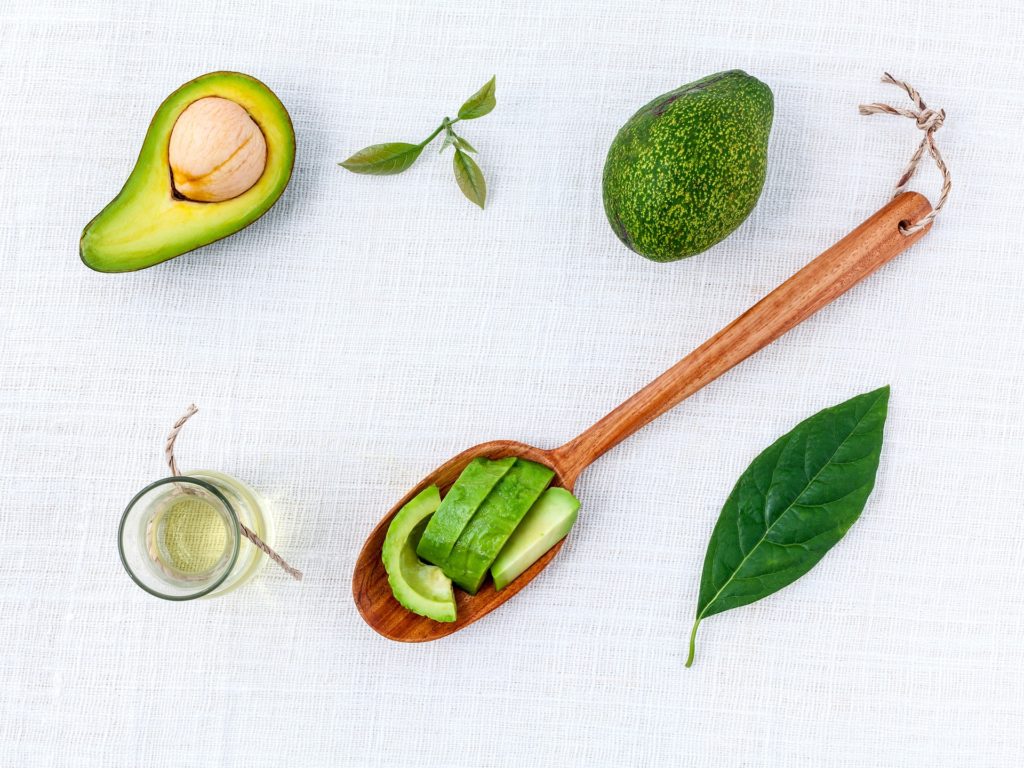
Avocado Beneficial for Weight Loss
A 2018 randomized and controlled dose study that looked in improving cardio-metabolic risk factors in overweight and obese men and women found that the replacement of carbohydrates with 1/2 to a whole avocado during meals increased dilation of blood vessels as well as decreasing blood pressure, it improved endothelial function which is the inner lining of blood vessels (as well as the heart) and improved blood sugar and cholesterol balance in the body. The addition of avocado into the diets of the overweight and obese participants of the study also provided them with nutrients that they otherwise would not obtain from their diet as well as beneficial oleic acid, which reduces systemic inflammation (Park, E., et al., 2018).
Cancer and Avocado Extract
Cyclophosphamide, a medication used as chemotherapy targets cancer cells, however, it also reduces white blood cell counts and inadvertently lowers the patient’s immune system. This medication is beneficial, especially for those with blood cancer, however, it is also a genotoxin, therefore, it is important to consume chemoprotective foods such as avocados. Avocado extract, due to its antioxidant and phytochemical content has been shown to reduce the cyclophosphamide effect of chromosomal numerical aberrations, which refers to chromosome division failure, which will result in either cell with additional chromosomes or a chromosome insufficiency (Paul, R., et al, 2011).
Avocados themselves have an inhibiting effect, provided by their antioxidant content (Persin and Persenones a and b), on the generation and selective killing of human oral malignant cells (Paul, R., et al., 2011).
Reducing Inflammation and Joint Pain
Avocado may aid in minimizing pain and stiffness as well as improving joint function. A study from 2015, found that avocado combined with soybeans was shown to reduce pain in patients with osteoarthritis as well as reducing dependence on pain killers (Christiansen, B.A., et al., 2015).
Beneficial for Diabetics
Type one diabetes requires external insulin while type two diabetes initially can be dealt with diet and lifestyle changes to bring insulin sensitivity back on track. Replacing certain carbohydrates in your diet with an avocado which is rich in monounsaturated fat can improve glycemic control in diabetics. Not only does an avocado provide a great source of fat, but also a great source of fiber allowing for a slower release of glucose, bringing more stability to one’s blood sugar levels (Ed. Terry, L., 2011).
A study from 1994, found that the replacement of carbohydrates with avocado has a positive on improving lipid profiles as well as glycemic controls in non-insulin dependent diabetics, making the fruit a beneficial alternative to blood sugar management. The study found that the consumption of avocado by non-insulin dependent diabetics also reduced their cholesterol levels (Lerman- Garber, I., et al).
A study found that overweight individuals who had consumed half an avocado with a meal found that they had better satiety for a period of between 3-5 hours after the meal, as well as a reduction in insulin secretion in 3 hours postprandial period (Weschenfelder, C., et al., 2015).
Avocado oil is also beneficial for liver regeneration and as a daily supplement and can be taken orally by type 1 diabetics (Gupta, S.K., et al., 2018).
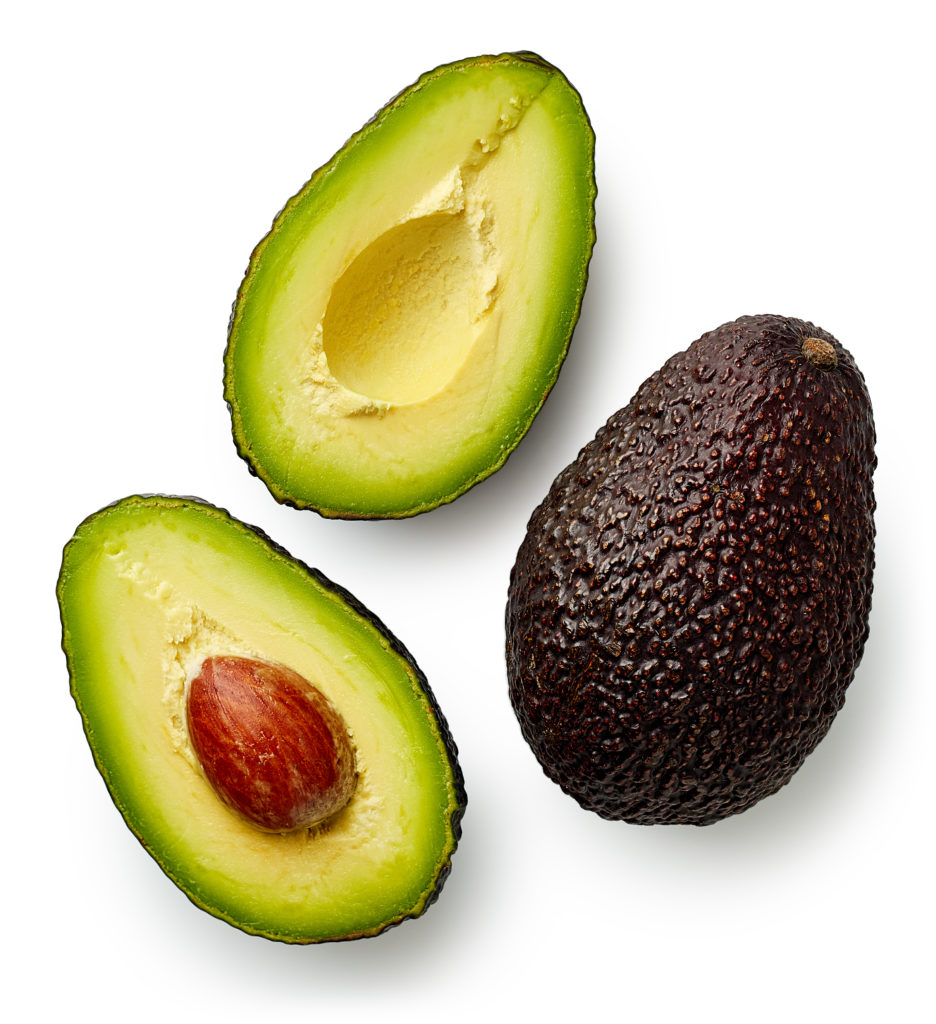
Anti-fungal Properties of Avocado
Certain compounds within the avocado display anti-fungal properties, such as 1-Acetoxy-2-hydroxy-4-oxo-heneicosa-5,12,15-triene, a compound that can be beneficial at combating Candida overgrowth (Gupta, S.K., et al., 2018).
Avocado Nutrition
The entire avocado the peel, pulp, and seed are a rich source of bio compounds (Araujo, R, G., et al., 2018). It is bountiful in phenolic compounds like lutein which is the primary carotenoid in the fruit and smaller quantities alpha and beta carotene and zeaxanthin. These compounds provide health benefits such as tocopherol, which may have anti-carcinogenic effects (Gupta, S.K., et al., 2018).
The wonderful thing about avocados is that they mature once they have been picked. Whereas most fruit matures on the bush, tree, etc., an avocado needs to be picked for it to become edible. Moreover, an earlier harvest has been shown to increase antioxidant, phenolic, glutathione and vitamin C levels within the fruit (Wang, M., et al., 2012).
|
100-gram Avocado | |
|
Calories |
160 kcal |
|
Carbohydrates |
8.53 g |
|
Sugars |
0.66 g |
|
Fiber |
6.7 g |
|
Fat |
14.66 g |
|
Protein |
2.00 g |
|
Potassium |
485 mg |
|
Magnesium |
29 mg |
|
Vitamin E |
2 mg |
|
phytosterols |
57 mg |
|
Calcium |
12 mg |
|
Phosphorus |
52 mg |
|
Vitamin C |
10 mg |
|
Folate |
81 ug |
|
Retinol |
146 IU |
|
Niacin |
1.738 mg |
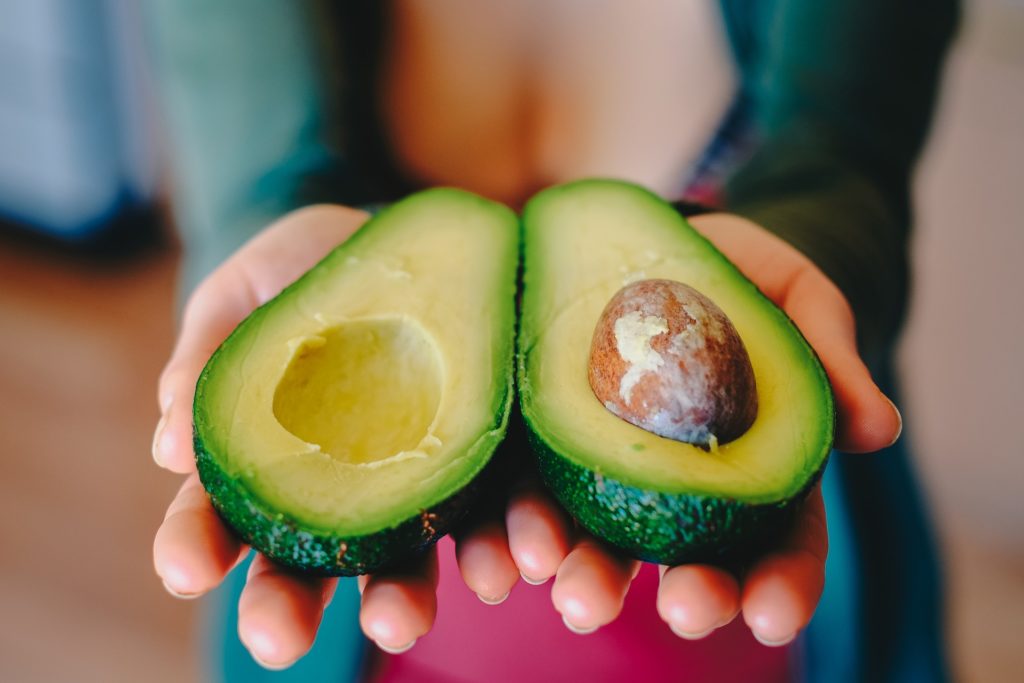
Essential Fatty Acids
Avocado is a rich source of monounsaturated fatty acids (MUFAs), with the fruit containing about 71% MUFAs. It also contains about 13% polyunsaturated and 16% saturated fatty acids (Weschenfelder, C., et al., 2015).
Vitamin and Minerals
Vitamin B6, present in avocados is incredibly nourishing to the nervous system, red blood cells, teeth, and gums, as well as stimulating peristalsis. B vitamins, in general, are often limited in the diets of children and adults throughout North America, added stress from work and social situations, will result in a higher requirement of the nutrient, as it is water-soluble and not stored in the body, it is often used up quickly Within an avocado you will find three times as much B6 as within a banana, Adding half of an avocado to your diet on a daily basis can make a big difference in terms of your digestive health (Gupta, S.K., et al., 2018).
Protein
A Hass avocado contains approximately 2.4% protein as well as continuing 9 essential amino acids. It is a source of asparagine, aspartic acid, glutamine, and glutamic acid, in smaller quantities, it also contains threonine, alanine, valine and cysteine (Ed. Terry. L., 2012).
Phenolic Compounds
Plant compounds in the avocado change depending on the season they are harvested as well as where and how they are grown. The total fat content within the fruit also plays a roll in the amount of carotenoids present (Lu, Q.L., et al., 2009).
There are five main carotenoids present in avocados; lutein, B-cryptoxanthin, zeaxanthin, alpha-carotene, and beta-carotene. They are more concentrated in the dark green flesh which is found closer to the skin of the fruit and the fat content of the avocado aids in their absorption. Lutein accounts for 70% of the carotenoid content within the fruit, aids in reducing the risk of macular degeneration (ed. Terry. L., 2012).
Avocados are also rich in phytosterols (what are they). They have been shown to balance serum cholesterol levels as well as aiding in the prevention of cardiovascular disease (Ed. Terry., 2012).
Fiber
Avocados are rich in fiber. They contain approximately 75% insoluble and 25% soluble (Weschenfelder, C., et al., 2015).
Avocados an Important Fruit in the Ketogenic Diet
The ketogenic diet is a high fat low carbohydrate diet. Were a Standard American Diet has between 50-65% energy from carbohydrates the keto diet restricts carbs to below 10% of consumed calories. This results in a switch from glucose metabolism to the metabolism of ketone bodies for energy. Historically this diet has been used for children with epilepsy, however, today it has become a popular diet for weight loss, athletes and as a way to improve health for people with Alzheimer’s and Diabetics (Taylor, M.K., et al., 2019).
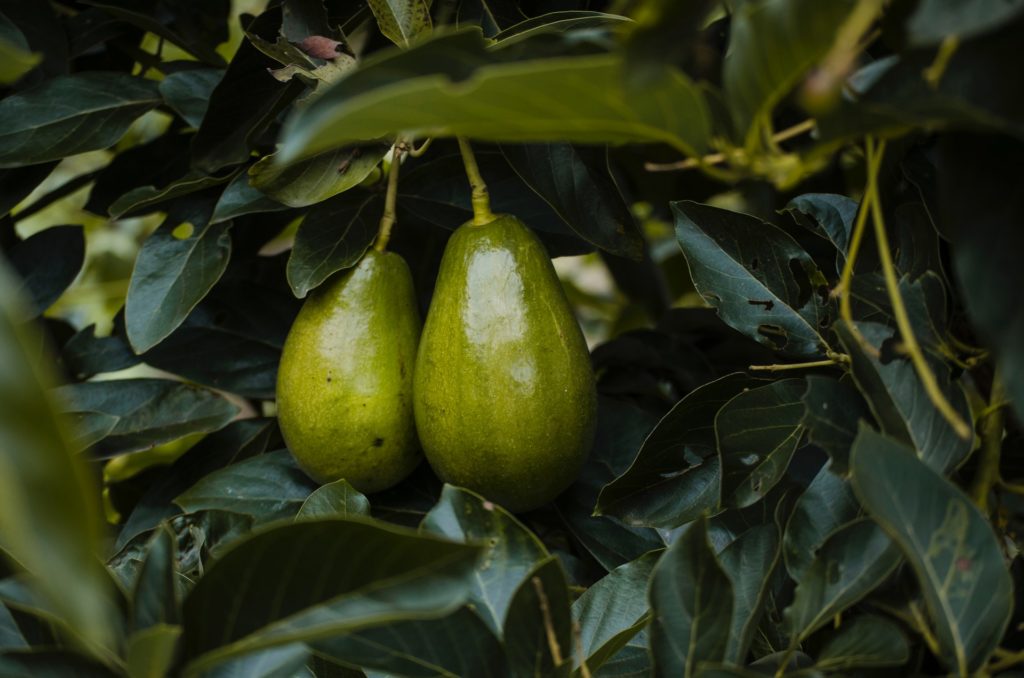
Types of Avocado and History
The earliest archeological evidence of avocados dates back to the 700s were a mummy in Peru was found buried with avocado seeds, however, they have likely been consumed for over 9000 years (Ed. Terry. L., 2011). In the 1800s avocado was bouquet over to Asia, where it spread.
The Mayans and the Aztecs semi-domesticated the fruit through the selection of larger and more edible avocados. There are three distinct races of avocados, they are; Mexican, Guatemalan, and Lowland – previously known as the West Indian.
The Mexican avocado is cultivated at high altitudes and has adapted to a cooler and dryer climate. It is plum-sized, with dark green flesh that turns deep purple as it ripens. It is harvested later in the season and is a hardy variety.
The Guatemalan variety is a native to the tropical highlands, growing well in cool as well as warmer climates. It is a large fruit with rather tough skin and just like the Mexican variety it turns from green to deep purple as it ripens. It is harvested early in the season, this variety stores very well.
The Lowland avocado thrives in a hot and humid environment that has a short dry season, however, this variety of fruit has a lower percentage of oil compared to other commercial varieties. This avocado is the largest of the three varieties, approximately 1 kg in weight, it has a light green colored flesh which does not change as it ripens (Ed. Terry, L., 2011) (Davidson, A., 1999).
The Hass Avocado is the most commonly produced and consumed a variety of avocado today. It most likely a combination of the Guatemalan variety with select genes from the Mexican avocado. Its color changes as it ripens, from green to a deep dark purple, as well as having a thicker skin to protect against disease and insects (ibid).
How to Store them and When Are They Ripe
The Avocado ripens off the tree when harvested at its peak it will ripen within a week to two weeks at room temperature, however, in refrigeration, it will keep for far longer. The avocado is ripe when the fruit feels squishy, particularly close to the stem of the fruit. There are certain avocados, such as the Hass avocado that change in color as they ripen, from a green to a dark purple when fully ripe. However, for those avocados that do not have a change in their color, testing the softness of the flesh, particularly around the stem of the fruit is the best way to test the ripeness of the fruit.
References
Araujo, R.G. , Rodriguez-Jasso, R.M., Ruiz, H.A., Pintado, M.M.E., Arguilar, C.N. (2018). Avocado by-products: Nutritional and functional properties. Trends in Food Science and technology. Volume 80, pages 51-60.
Ashton, O.B.O., Wong, M., McGhie, T.K., Vather, R., Wang, Y., Requejo-Jackman, C., Ramankutty, P., Woolf, A.B. (2006). Pigments in Avocado Tissue and Oil. Journal of Agricultural and Food Chemistry. Volume 54, Issue 26, pages 10151-10158.
Christiansen, B.A., Bhatti, S., Goudarzi, R., Emami, S. (2015). Management of Osteoarthritis with Avocado/Soybean Unsaponifiable. Cartilage. Volume 6, Issue 1, page 30-44.
Davidson, A. (1999). The Oxford Companion To Food. Oxford University Press; Oxford.
Gupta, S.K., Singhal, P., Singh, A., Chauhan, R., Kumar, B. (2018). Nutritional and Pharmaceutical Benefits of Avocado Plants. Journal of Advanced Scientific Research. Volume 9, Issue 2, pages 4-11.
Imafidon, K.E., Amaechina, F.C. (2010). Effects of Aqueous Seed Extract of Persea Americana Mill. (Avocado) on Blood Pressure and Lipid Profile in Hypertensive Rats. Advances in Biological Research. Volume 4, Issue 2, pages 116-121.
Lopez, L.R., Frati, M.A.C., Hernandez, D.B.C., Cerrantes, M.S., Hernandez., L.M.H., Juarez, C., Moran, L.S. (1996). Monounsaturated Fatty Acid (Avocado) Rich diet for mild hypercholesterolemia. Archives of Medical Research. Volume 24, Issue 4, pages 519-523.
Lu, Q.L., Zhang, Y., Wang, Y., Wang, D., Lee, R., Gao, K., Byrns, R., Heber, D. (2009). California Hass Avocado: Profiling of Carotenoids, Tocopherol, Fatty Acid, and fat Content during Maturation and from Different Growing Areas. Journal of Agricultural and Food Chemistry. Volume 57, Issue 21 pages 10408-10413.
Mahmassani, H.A., Avendano, E.E., Raman, G., Johnson, E.J. (2018). Avocado Consumption and Risk Factors for Heart Disease: A Systematic review and meta-analysis. The American Journal of Clinical Nutrition. Volume 107, issue 4, pages 523-536.
Park, E., Edirisinghe, I., Burton-Freeman, B. (2018). Avocado Fruit on Postprandial Markers of Cardio-Metabolic Risk: A Randomized Controlled Dose-Response Trial in Overweight and Obese Men and Women. Nutrients. Volume 10, Issue 9, page 1287.
Paul, R., Kulkorni, P., Ganesh, N. (2011). Avocado fruit (Perse Americana Mill) exhibit chemo-protective potentiality against cyclophosphamide-induced genotoxicity inhumane Lymphocyte culture. Journal of Experimental Therapeutics and Oncology. Volume 9, page 221-230.
Peou, S., Millard-hasting, B., Shah, S.A. (2016). Impact of avocado-enriched diets on plasma lipoproteins: A meta-analysis. Journal of Clinical Lipidology. Volume 10, Issue 1, pages 161-171.
Rahman, S. (2019). Effect of Avocado to LDL Cholesterol as a Preventive Risk of Atherosclerosis. International Journal of Multidisciplinary and Current Research. Volume 7.
Tabeshepour, J., Razavi, B.M., Hosseinzaden, H. (2017). Effect of Avocado (Persea Americana) on Metabolic syndrome: A Comprehensive Systemic Review. Phytotherapy Research. Volume 31, Issue 6, page 819-837.
Tan, C.X., Chong, GH., Hamzah, H., Ghazali, H.M. (2018). Hypocholesterolemic and hepatoprotective effects of virgin avocado oil in diets induced hypercholesterolemic rats. International Journal of Food Science and technology. Volume 53, Issue 12, pages 2706-2713.
Taylor, M.K., Swerdlow, R.H., Burns, J.M., Sullivan, D.K. (2019). An Experimental Ketogenic Diet for Alzheimer’s Disease Was Nutritionally Dense and Rich in Vegetables and Avocado. Current Developments in Nutrition. Volume 3, Issue 4.
Ed. Terry, L. (2011). Health-Promoting Properties of Fruits and Vegetables. Avocado. CABI, Oxfordshire.
Wang, M., Zheng, Y., Khuong, T., Lovatt, C.J. (2012). Effect of harvest date on the nutritional quality and antioxidant capacity in Hass avocado during storage. Food Chemistry. Volume 135, Issue 1, pages 694-698.
Eds. Whiley, A.W., Schaffer, B., Wolstenholme, B.N. (2002) The Avocado: Botany, Production, and Uses. CABI Publishing, Cambridge
Weschenfelder, C., dos Santos, J.L., de Souza, P. A. L., de Campos, V.P., Marcadenti, A. (2015). Avocado and Cardiovascular Health. Open Journal of Endocrine and Metabolic Diseases. Volume 5, pages 77-83.
Amanda Filipowicz is a certified nutritional practitioner (CNP) with a bachelor in environmental studies (BES) from York University. She also has certification in clinical detoxification, prenatal and postnatal care as well as nutrition for mental health. She has been working as a nutritionist since 2013 and is a lifelong proponent of eating healthy.

